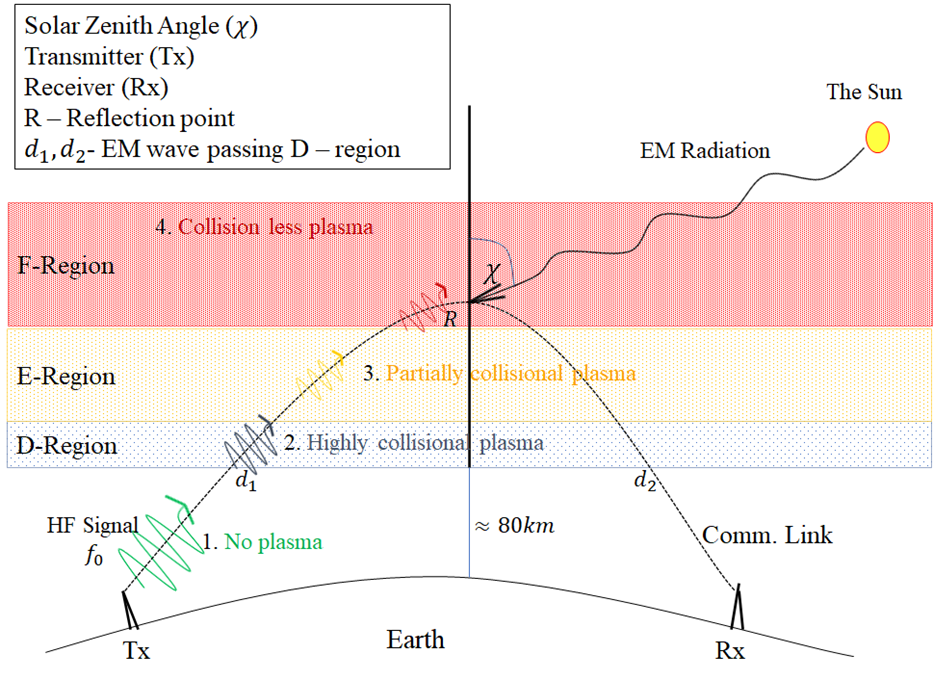North America SWF Monitoring & X-RAP Modeling
North America SWF Monitoring & X-RAP Modeling
The X-ray, Extreme Ultra Violate (EUV) radiation released during a solar X-ray flare induces electron density enhancement in the dayside D-region ionosphere1. This heightened electron density has the capacity to elevate absorption in the high frequency (HF:3-30 MHz) range, specifically between 3 and 30 MHz. The consequence is a reduction in signal strength, affecting shortwave radio transmissions, commonly known as shortwave fadeout, SWF.

This monitoring tool provides a summary of flare impacts on SuperDARN HF radar observations in the North American (NA) sector with an emphasis on ShortWave Fadeout (SWF). Specifically, tool provides the following data/analysis products:
- Event-based Summary Reports: Pre-loaded events by calendar, showing solar irradiance (at X-ray band) condition and associated ionospheric/HF response recorded by SuperDARN.
- New HF absorption model: Pre-loaded modeled events by calendar, showing solar irradiance (at X-ray band) condition and modeled HF condition during the peak of the flare.
Note that the calendars list only the highest flare on an UT day. If you need analysis of a specific flare event please contact Shibaji Chakraborty, J. Michael Ruohoniemi.
Event-based Summary Reports
Summary report of GOES X-Ray irradiance. Flare class and peak time is identified in the Soft X-ray spectrum (SXR, red). Summary report of a sub-network of SuperDARN radar chain distributed across the middle and high-latitudes of the North American Sector. SWF phase timings [onset, blackout, recovery start, and end] and phase durations [onset, backout, and recovery] are estimated from the backscatter count
<E>parameter. Thresholds and algorithm is defined in Chakraborty et al. (2018)2. Please find example event and parameter description in this webpage.
X-Ray Irradiance driven d-Region Absorption Prediction (X-RAP)
In our endeavor to refine space weather predictions, we employ a data-driven approach by fitting a sophisticated model using real-time observations from both GOES X-ray and riometer instruments. Latest study by Fiori et al. (2022)3 optimized a simple absorption model using data from solar X-ray flares and riometer stations across Canada. In a specific event study, our optimized model showed a 1% overestimation of absorption during an X2.1 solar X-ray flare, correcting an underestimation by the NOAA D-region Absorption Prediction (D-RAP) model. In a broader statistical study involving 87 events, event-by-event optimization demonstrated excellent agreement between measured and modeled data, with a Pearson correlation coefficient (R) of 0.88 and a slope (m) of 0.91. The study also developed a generalized model using data from all events, showing slightly reduced correlation (R = 0.75) and slope (m = 0.80). The model’s accuracy, evaluated by prediction efficiency, peaked at 0.78 for event-by-event analysis and 0.48 for the collective dataset. This new HF absorption model is also presented along with DRAP4 5 6 7 model output. Please find example event and parameter description in this webpage.
Acknowledgements:
The Blackstone and Fort Hays SuperDARN radars are maintained and operated by Virginia Tech under support by NSF grant AGS-1935110. We acknowledge the use of SuperDARN data. SuperDARN is a network of radars funded by national scientific funding agencies of Australia, Canada, China, France, Italy, Japan, Norway, South Africa, the United Kingdom, and the United States of America. We wish to acknowledge the use of the NOAA/GOES X-ray dataset for flare confirmation and dataset. This work is funded by the NASA with grant number SWR2O2R 80NSSC20K1380.
Open Science:
Refer VT SuperDARN Website for the dataset used in this analysis. Methodology is described in our SWF characterization paper (Chakraborty et al. 20182). Analysis .py files are stored in GitHub.
References:
-
Davies, K., Ionospheric Radio. Peregrinus Ltd., London, UK. 1990. ↩
-
Chakraborty, S., Ruohoniemi, J. M., Baker, J. B. H., & Nishitani, N. (2018). Characterization of short-wave fadeout seen in daytime SuperDARN ground scatter observations. Radio Science, 53, 472–484. https://doi.org/10.1002/2017RS006488 ↩ ↩2
-
R.A.D. Fiori, S. Chakraborty, L. Nikitina, Data-based optimization of a simple shortwave fadeout absorption model, Journal of Atmospheric and Solar-Terrestrial Physics Volume 230, 2022, 105843, ISSN 1364-6826, https://doi.org/10.1016/j.jastp.2022.105843. ↩
-
Sauer, H. H., and D. C. Wilkinson, A Global Space Weather Model of Ionospheric HF/VHF Radio-Wave Absorption due to Solar Energetic Protons,Space Weather, submitted, 2008. ↩
-
Space Environmental Forecaster Operations Manual, page 4.3.1, 55th Space Weather Squadron, Falcon AFB, USAF, 21 October 1997. ↩
-
Stonehocker, G. H., Advanced Telecommunication Forecasting Technique, in Ionospheric Forecasting, AGARD CONF. Proc. No. 49, Advisory Group for Aerospace Research and Development, NATO; Agy, V. (Ed), p27-1, 1970. ↩
-
NOAA, SWPC, Global D-Region Absorption Prediction, https://www.swpc.noaa.gov/content/global-d-region-absorption-prediction-documentation ↩